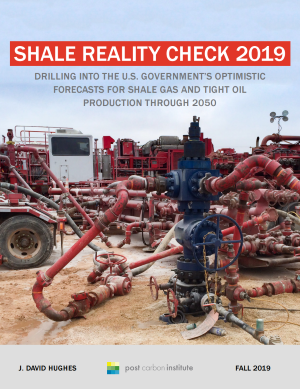
Shale Reality Check 2019
November 12, 2019
See the next report in this series: Shale Reality Check 2021.
In Shale Reality Check 2019, earth scientist J. David Hughes assesses the viability of the U.S. Energy Information Administration’s (EIA) shale forecasts in its Annual Energy Outlook 2019, which are widely used by policymakers, industry, and investors to make long-term plans. His detailed analysis finds that the EIA’s forecasts of tight oil and shale gas production through 2050 are extremely optimistic, and highly unlikely to be realized.
Read the other reports in this series at shalebubble.org.
Synopsis
Shale Reality Check 2019 provides a realistic assessment of future production in the the top 13 tight oil and shale gas plays in the United States.
Prepared by earth scientist J. David Hughes, the report is based on an analysis of well production data for all major shale gas and tight oil plays in the U.S. These plays make up 90% of the EIA’s Annual Energy Outlook 2019 (AEO2019) reference case production forecast for shale gas and tight oil for the period 2017–2050. Along with references from the literature, the key data source is Enverus (formerly Drillinginfo), a commercial database of well-level production data which is utilized by the EIA and most major oil and gas companies.
For each play, this report assesses:
- Current and historical production and cumulative oil and gas production by county.
- Total- and producing-well count by county, well type, and vintage.
- Three-year well decline and first-year field decline by county, well type, and vintage.
- Distribution of wells in terms of quality, as defined by production of oil or gas in the highest month (initial productivity), in order to delineate sweet spots.
- Average productivity of all wells drilled in each year from 2012 to 2018 by county, well type, and play, in order to assess the impact of improved technology.
- Definition of prospective drilled area to determine the area which might reasonably contribute to future production.
- Projected number of wells, well density, and capital investment required to meet production forecasts.
- Comparison of forecast production to EIA estimates of proven reserves plus unproven resources.
- The optimism bias for the EIA AEO2019 play-level forecasts based on play fundamentals determined from the assessment.
